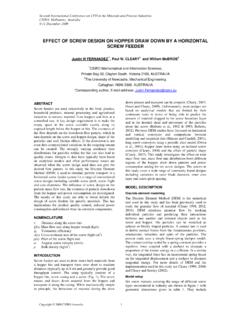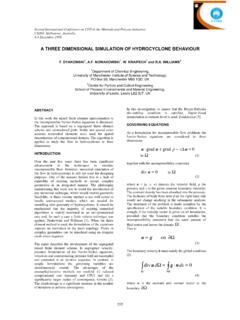Transcription of ANALYSIS OF CURRENT- INDUCED FORCES ON OFFSHORE …
1 Fifth International Conference on CFD in the Process Industries CSIRO, Melbourne, Australia 13-15 December 2006. ANALYSIS OF CURRENT- INDUCED FORCES ON OFFSHORE pipeline . BUNDLES. M H KAMARUDIN1, K P THIAGARAJAN2 , A CZAJKO3. 1, 2. School of Oil & Gas Engineering, University of Western Australia, Crawley, WA 6009. 3. J P Kenny Pty Ltd., Perth, Western Australia 6000. U horizontal current INDUCED velocity ABSTRACT density of fluid (water). OFFSHORE pipelines are often accompanied by smaller diameter service lines or umbilicals to create a bundle. INTRODUCTION. The flow behaviour around a pipeline bundle is complex OFFSHORE pipelines are usually subject to wave and current and not well known and this leads to the concern on the loading. This will exert FORCES on the pipelines which later stability of the configuration. This paper investigates the may result in pipeline failure if the design limits are influence of the piggyback pipeline on the hydrodynamic exceeded.
2 Many OFFSHORE pipelines are accompanied by a loading of the bundle in steady current flow using a smaller diameter service line or umbilical to create a Computational Fluid Dynamics (CFD) package, bundle. It is expected that the existence of the piggyback FLUENT. The research undertaken is compared against pipeline may have some effects on the hydrodynamic established industry practice of assuming that the FORCES of the main pipeline . The flow behaviour around a hydrodynamic characteristics for the bundle are the same pipeline bundle is complex and not well known and this as an equivalent diameter cylinder. Key parameters of the leads to concern on the stability of the configuration. This configuration that were investigated were the orientation in turn may require some modifications in pipeline of the smaller pipe with respect to the main pipeline , and configuration to ensure that the piggyback pipeline is the flow conditions.
3 The gap between the seabed and the stable. This may be achieved by increasing the mass of the main pipe was set to zero for all cases investigated. The pipelines via a concrete weight coating or increased wall results of the numerical analyses showed that the presence thickness (DNV, 1988). However, this can result in of the piggyback has a significant influence on the significant cost and may adversely affect pipeline hydrodynamic characteristics of the main pipe. The handling and installation. Thus, a fundamental need was Equivalent Diameter approach adopted in engineering identified for detailed examination of the external design may underestimate the FORCES on the bundle. It was hydrodynamic loading on this type of configuration. We also found that the orientation of the piggyback plays an consider in this paper the influence of current only essential role in determining the drag and lift coefficients loading.
4 Instabilities in loading such as due to combined for the bundle. This phenomenon is better understood by waves and currents will be discussed in a forthcoming examining the pressure distribution around the cylinder. paper by the authors. NOMENCLATURE Pipelines exposed to a steady current will experience an in-line force as well as a transverse force . The magnitude A frontal area of cylinder of these FORCES depends on the Reynolds number. This is reference location of the small cylinder with due to the importance of the boundary layer in the viscous respect to the main cylinder region around the pipe surface. The contribution of the in- CD drag coefficient line and the transverse FORCES are the results of the skin CL lift coefficient friction and also the pressure distribution around the pipe Cp pressure coefficient that act in-line and normal to the flow respectively. They d diameter of the small cylinder can be represented as.
5 D diameter of the main cylinder e gap between main cylinder and seabed 1. FD = C D AU | U |. FD drag force 2. FL lift force 1. F L = CL AU | U | (1). G gap between main cylinder and small cylinder 2. p pressure where symbols are defined in the nomenclature. Even Re Reynolds number though much theoretical and experimental research has . Corresponding author 1. Now with INTEC Engineering, Perth 1. been done to study the hydrodynamic characteristics on k . twin and multiple cylinder configurations, most appears to ( k) + ( kui ) = ( + t ) +Gk + Gb YM + Sk t xi xj k xj (2). be confined to cylinders of equal diameter. Very little information is available on the effect of hydrodynamic and FORCES on the main pipeline with a piggyback configuration. Due to this lack of knowledge, the optimum k 2. ( ) + ( ui ) = ( + t ) + C1 (Gk + C3 Gb ) C2 + S . design parameters that minimise the total FORCES are not t xi xj xj k k well-known.
6 The design practice of a piggyback (3). configuration adopts an equivalent diameter approach whose validity has not been extensively researched. This Where Gk and Gb= turbulence kinetic energy due to the approach assumes that the hydrodynamic load on a mean velocity gradients and buoyancy respectively piggyback configuration is equivalent to a single cylinder whose diameter is the sum of the diameters of the main YM = contribution of the fluctuating dilatation in and piggyback plus the gap in between. In this paper, we compressible turbulence to the overall dissipation rate use a computational approach to model a piggyback k and = turbulent Prandtl numbers cylinder and compare the loads on an equivalent diameter Sk and S = optional user-defined source terms (not used cylinder. The influence of different parameters of the here). configuration on this comparison is studied. C2 and C3 = constants Further details may be had from FLUENT (2003).
7 MODEL DESCRIPTION. The numerical model was validated for uniform flow past Computational Domain a singular cylinder. The cylinder diameter was , A 2D numerical domain (Figure 1) was created to and the Reynolds number ranged from 10 to x 106. represent the model and its vicinity. Consideration was The computational domain was discretised into 113910. given to the grid around the wall of the cylinder and its structured mesh elements. The cylinder was located at the ability to capture the interactions between the vortices that mid-height of the computational domain. Symmetric may contribute to the hydrodynamic FORCES . The inlet boundary conditions were prescribed on the two lateral boundary was set far enough in front of the cylinder to boundaries. The drag coefficients computed were allow the flow to be fully developed by the time the flow compared with Schlicting (1979) and found to agree reaches the cylinder.
8 The minimum inlet distance was set within 10%. However, it has been found that the model at ten times the diameter of the main cylinder (10D). An fails to capture the drag crisis region between <. outflow boundary condition with no back pressure Re < where the transition from laminar to limitation was found to be suitable when the exit flow is in turbulent boundary layer occurs. As a further validation, a fully developed condition. A downstream distance of flow past a cylinder resting on the seabed was simulated twenty times the diameter of the main cylinder (20D) was for Reynolds number of 1x104. The drag coefficient was chosen. Ten times the diameter of the main cylinder (10D) found to be lower than the free stream case, in agreement was specified to be the height of the computational with experimental results by Jensen, et. al.(1990) and domain. Kiya, M. (1968) (as cited in Sumer and Fredsoe, 1997).
9 Further validation details may be found in Kamarudin (2005). 10D Description of Model Configurations In this study, the influence of piggyback on the main D cylinder is investigated. The main cylinder is fixed to the sea bottom (e/D=0) while the piggyback is situated at 10D 20D different orientations, Figure 2. The gap ratio between the main cylinder and the piggyback (G/D) is kept constant Figure 1: Geometry of Computational Domain Modelling Turbulence After some validation process, the Standard k- model with Enhanced Wall Treatment was chosen for this research. This is a semi-empirical model based on model transport equations for the turbulence kinetic energy (k). and its dissipation rate ( ). In the derivation of the k- . model, it is assumed that the flow is fully turbulent, and the effects of molecular viscosity are negligible (FLUENT, 2003). The following transport equation for turbulence kinetic energy, k, and the rate of dissipation.
10 Provide the necessary closure of the Navier-Stokes equations: Figure 2: Model Definition 2. at The diameter ratio of the small cylinder (d) to the RESULTS. main cylinder (D) is set to constant value of The force Coefficients on Main Cylinder diameter of the main pipe and the smaller pipe were chosen as (20 ) and (4 ) respectively. Figures 3 and 4 show the variations of the force coefficients on the main cylinder at different Reynolds Five orientations of piggyback configurations were numbers and piggyback configurations. For the purpose of simulated with =0, /4, /2, 3 /4 and as defined in comparison, the force coefficients on the single cylinder Figure 2. These configurations were based on commonly without the piggyback are also plotted. It can be seen that used designs in the industry. The Reynolds numbers the main cylinder experiences maximum mean drag simulated were 300, 1000, 10000, and coefficient when the small cylinder is on top of the main cylinder ( = /2) for all Reynolds numbers investigated.








